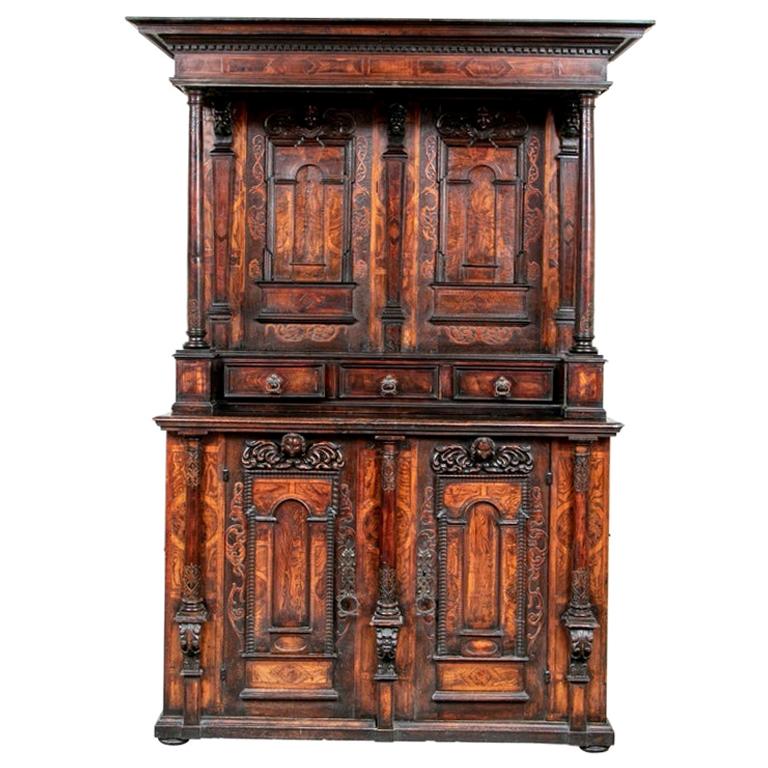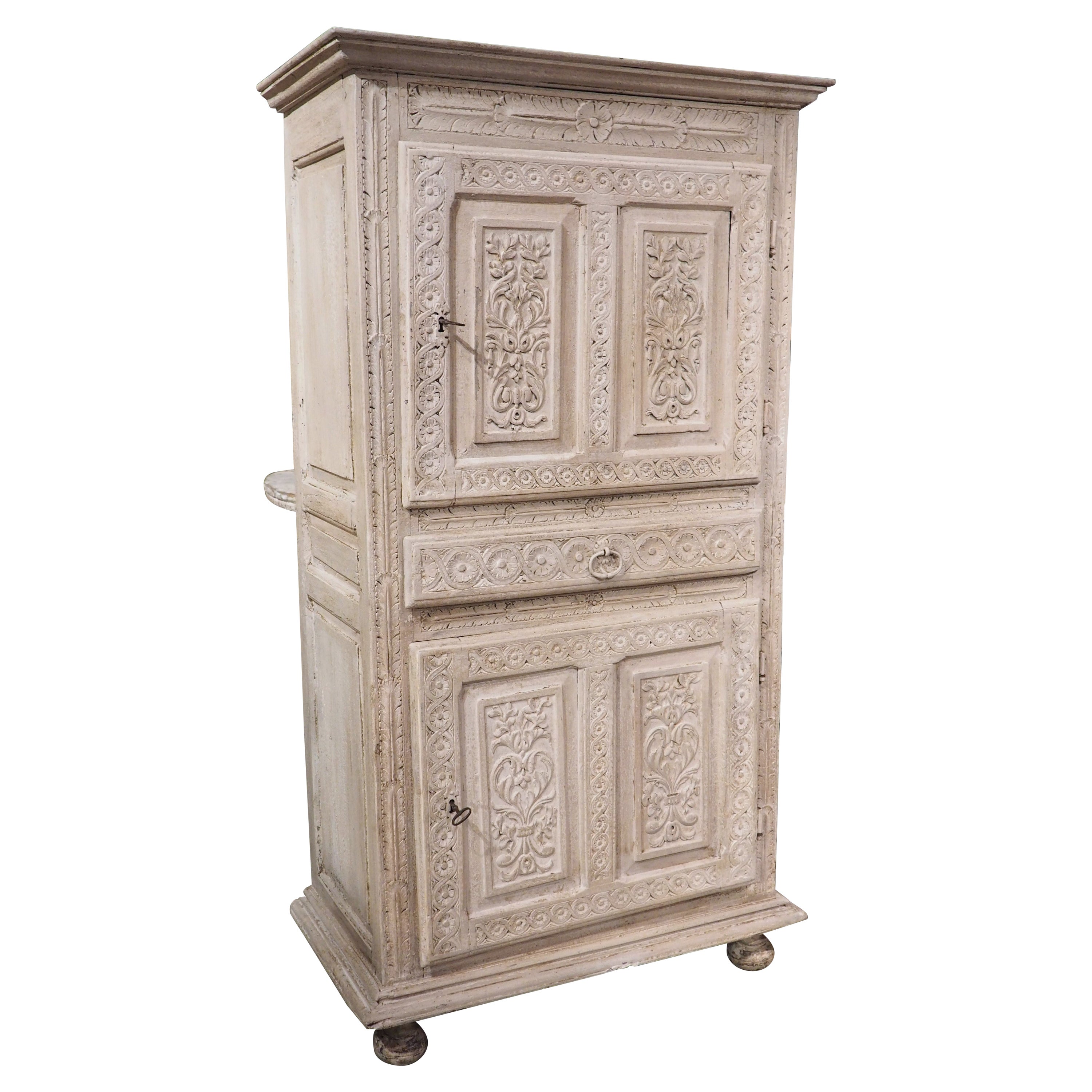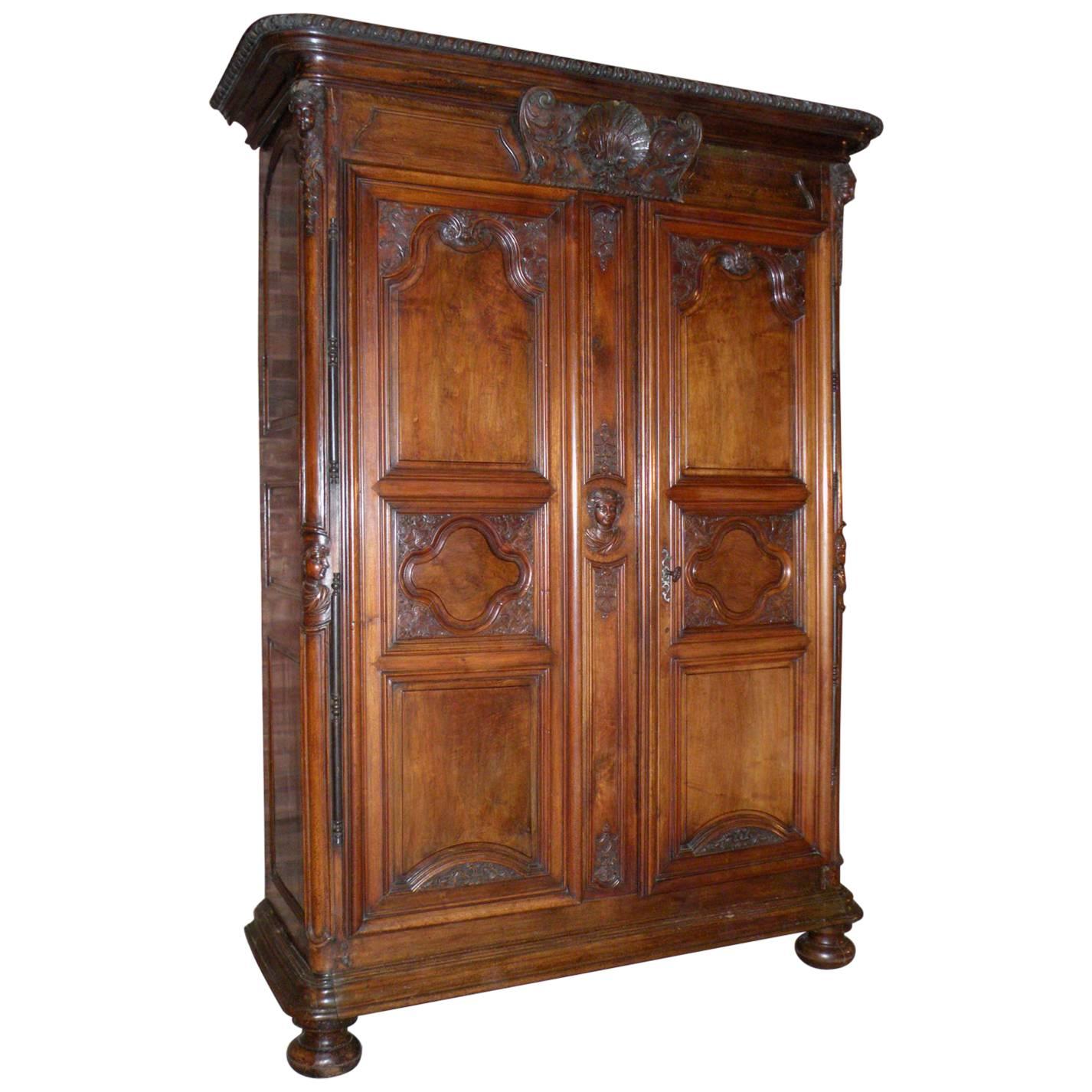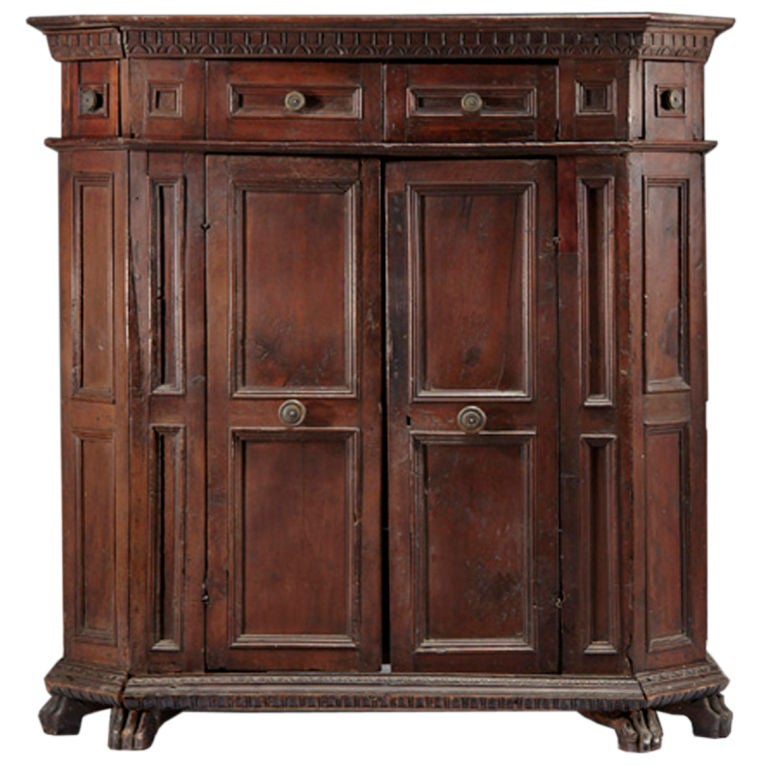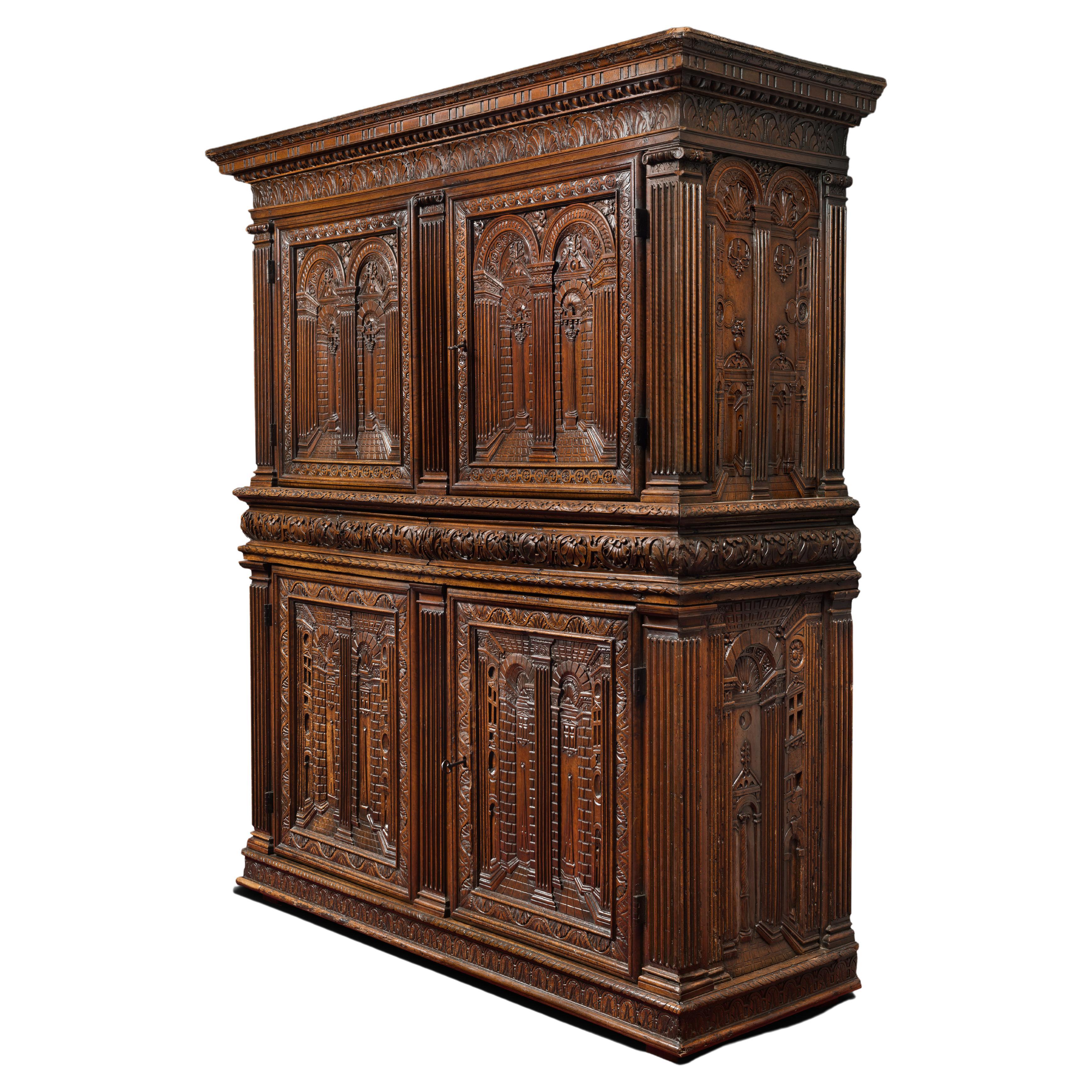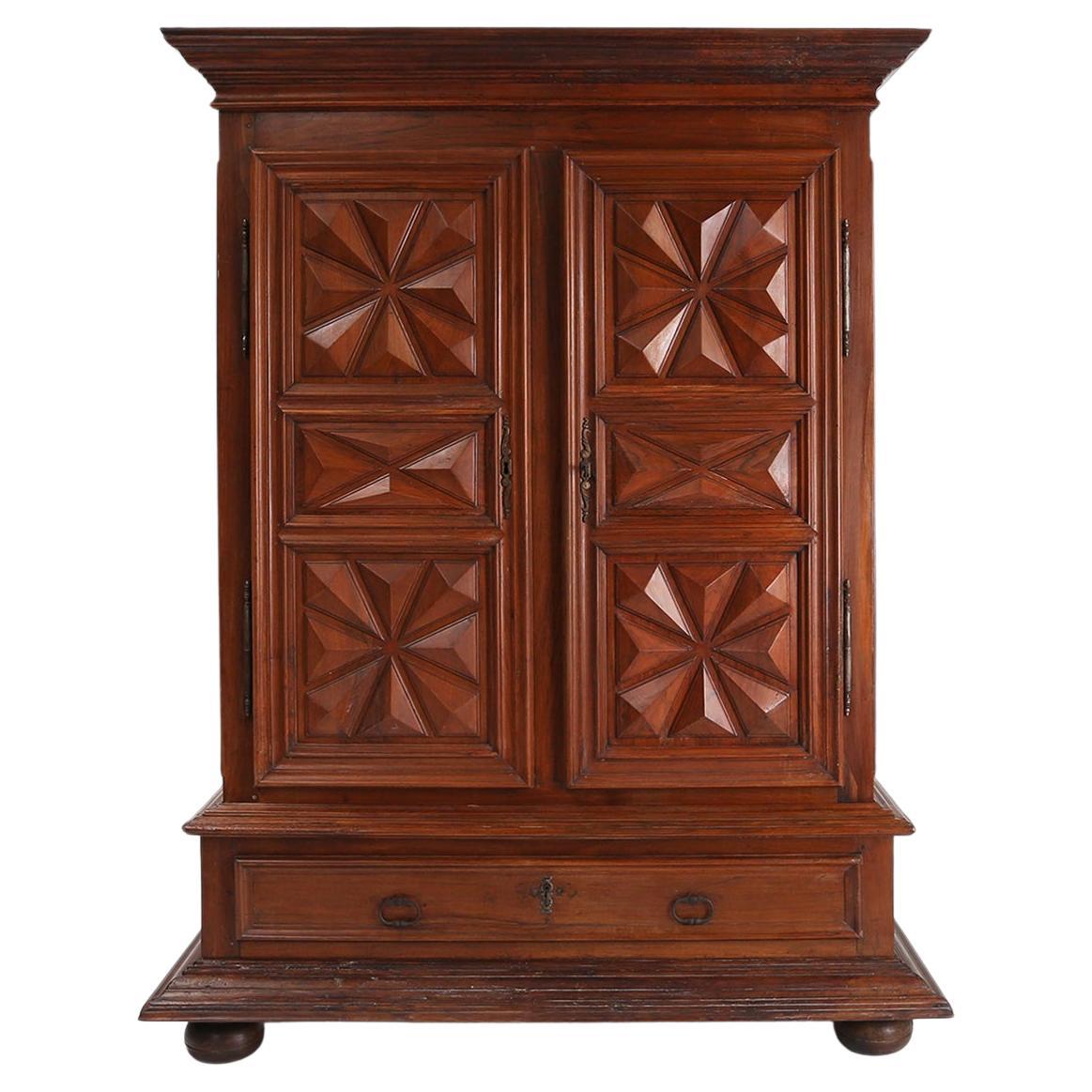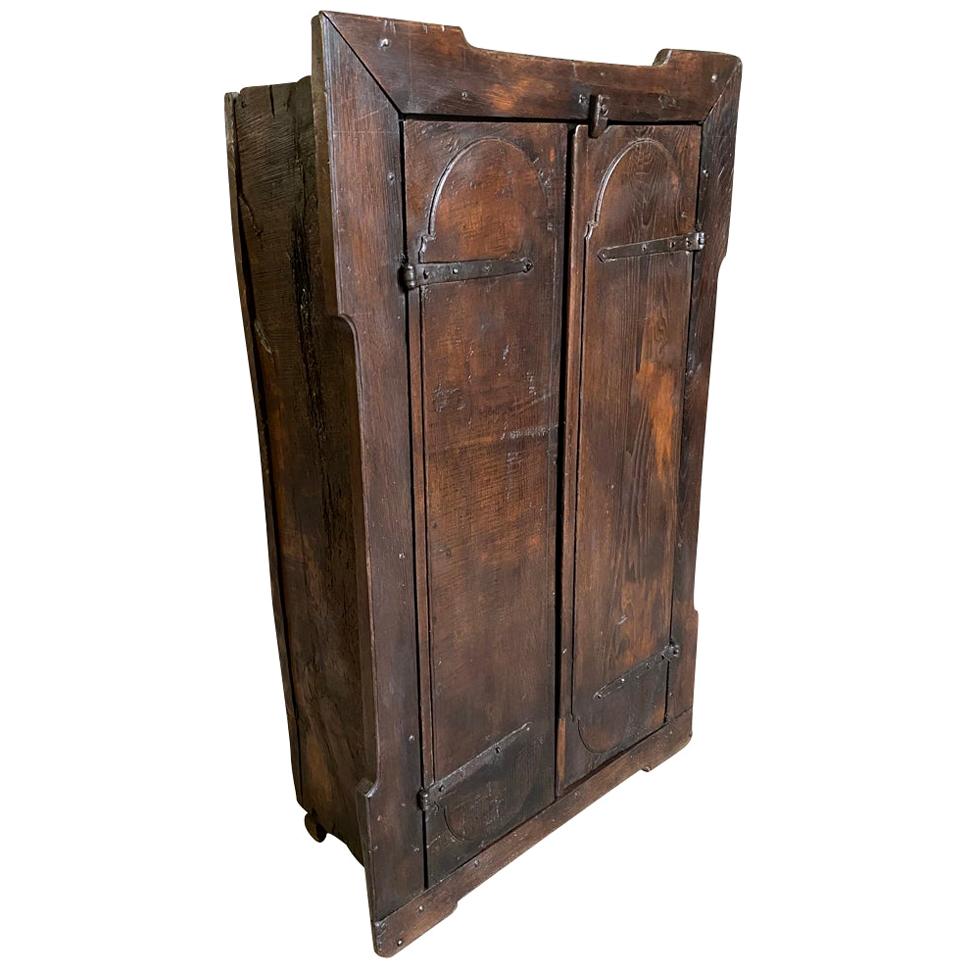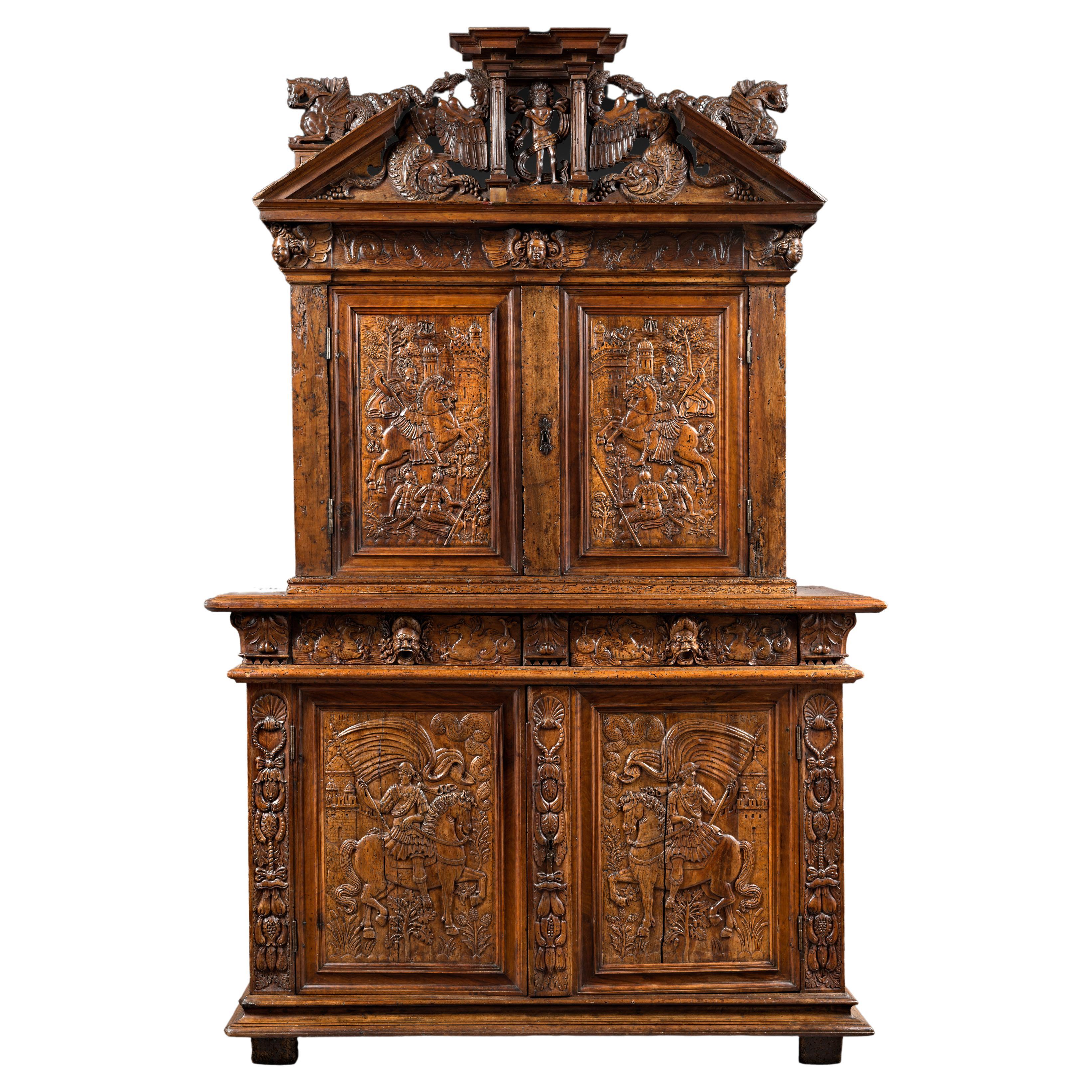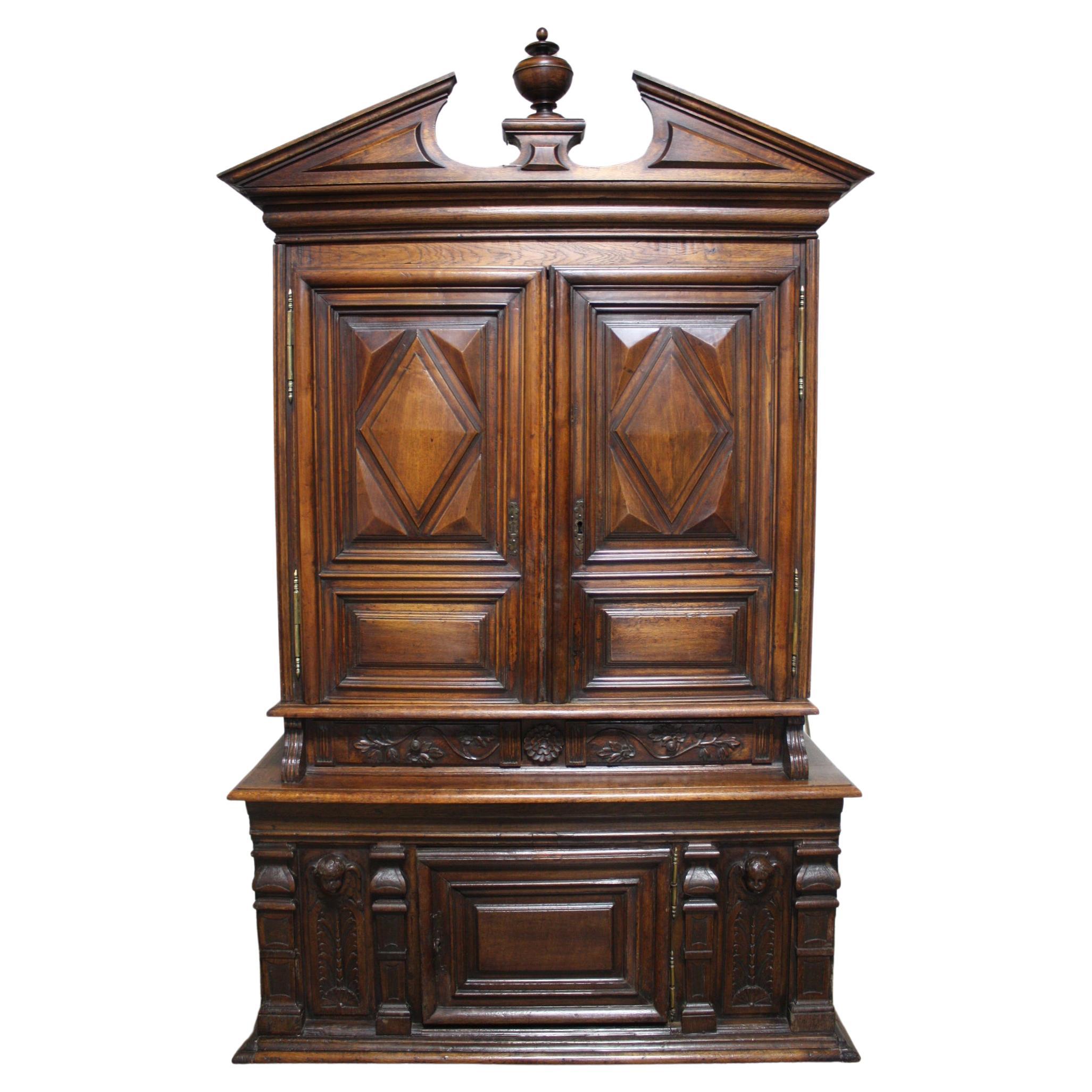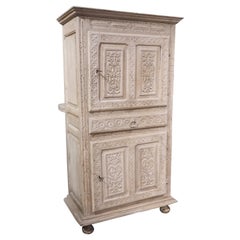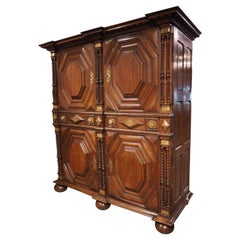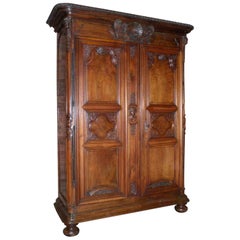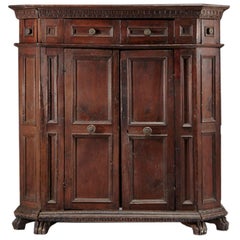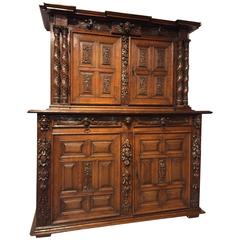
Rare Late Renaissance Cabinet from France, 17th Century
View Similar Items
Want more images or videos?
Request additional images or videos from the seller
1 of 11
Rare Late Renaissance Cabinet from France, 17th Century
About the Item
- Dimensions:Height: 78.5 in (199.39 cm)Width: 68.75 in (174.63 cm)Depth: 27.25 in (69.22 cm)
- Style:Renaissance (Of the Period)
- Materials and Techniques:
- Place of Origin:
- Period:Early 17th Century
- Date of Manufacture:Early to Mid-1700s
- Condition:Wear consistent with age and use. Minor losses. Good overall antique condition. Old restorations, recent restorations and partially replaced moldings (see photos) minor losses to some motifs, losses of wood, age separations and cracks. Commensurate with used condition of 1600s.
- Seller Location:Dallas, TX
- Reference Number:Seller: 415-201stDibs: LU90633394622
About the Seller
5.0
Platinum Seller
These expertly vetted sellers are 1stDibs' most experienced sellers and are rated highest by our customers.
Established in 1983
1stDibs seller since 2011
734 sales on 1stDibs
More From This SellerView All
- 17th Century Painted Oak Homme Debout Cabinet from Southwest FranceLocated in Dallas, TXA Homme debout is a two-bodied cabinet with a drawer separating the sections. This handsome Homme debout from southwest France was hand carved from oak in the 1600s. The period Louis...Category
Antique 17th Century French Louis XIII Cabinets
MaterialsWood, Paint
- Circa 1830, Italian, Walnut Wood Wall Cabinet in the Renaissance StyleLocated in Dallas, TXHand-carved in Italy, circa 1830, this walnut wall cabinet has numerous Renaissance style motifs. The details are quite amazing, with all available space utilized. Even the edges of ...Category
Antique 1830s Italian Renaissance Cabinets
MaterialsWood, Walnut
- Rare 17th Century Oak and Brass 4-Door Buffet from Saint-Malo, France, C. 1690Located in Dallas, TXThis grand and distinctive piece of furniture from Northern Brittany is known as a “buffet malouin” and was created in the late 17th century. These types of cabinets were created for important homes in the historic port city of Saint-Malo. The design, with large octagonal molded panels, double colonettes, and finely cut brass fittings, is unique to other French furniture of the period. The design was directly influenced by the Dutch mariner carpenters living in Saint-Malo at the time (the Dutch beeldenkast cabinet shows similarities) The large four-door cabinet was carved in oak, as was most of the other “malouin” furniture pieces. It is an imposing and impressive piece, standing over 7 feet tall and nearly 7 feet wide. The front of the piece has twisted, double colonettes, multi-profiled cushion-shaped octagonal panels, and finely cut brass key hole escutcheons, drawer pulls, and lozenge plates. There are 3 drawers, 2 of which are full sized, with a smaller drawer in the center. 3 large bun feet along the front hold up the entire piece, while 2 block feet support the rear. Each door has its own functioning key and lock, with a yet another key for the center drawer. Door and drawer panels are solid and impressive old pieces of oak, which still open and close with ease, indicating the quality of construction and great care that this piece has received over the centuries. The “meuble malouin” in the form of a large 4 door buffet is not often easily found. Research shows photos of several models in various states that have come to surface, but they were not nearly pervasive as French case...Category
Antique 1690s French Louis XIV Cupboards
MaterialsBrass
- Pair of 17th Century Renaissance Style Carved Panels from FranceLocated in Dallas, TXThese phenomenal hand-carved architectural panels date to the 1600s. They are completely carved in relief, and they are in the Renaissance style with motifs of scrolling rinceaux at ...Category
Antique 17th Century French Renaissance Panelling
MaterialsWood
$3,600 Sale Price / set25% Off - 17th Century French Walnut Wood Buffet Deux CorpsLocated in Dallas, TXThis unique buffet deux corps was hand-carved from walnut wood in France during the Louis XIII period (1600’s). A buffet deux corps (literally “two body buffet”) is a two-tiered cabi...Category
Antique 17th Century French Louis XIII Buffets
MaterialsWalnut
- Antique French Beauvais Tapestry from the Late 17th CenturyBy Beauvais Royal ManufactoryLocated in Dallas, TXThis is a large, horizontal fragment of a late 17th century Beauvais tapestry. Beauvais tapestry manufacture was one of the most well-known tapestry workshops in France. Beauvais was...Category
Antique Late 17th Century French Louis XIV Tapestries
MaterialsWool, Silk
You May Also Like
- Notable circa 17th Century Carved Walnut Two-Tiered Cabinet in Renaissance StyleLocated in Bridgeport, CTA large and impressive 17th century European cabinet. Made in two parts, both with elaborate carved decoration and burled panels and details. The upper cabinet with heavy overhanging...Category
Antique 17th Century European Renaissance Cabinets
MaterialsWood
- Late 17th Century French Louis Monumental XIV Walnut ArmoireLocated in Troy, NYVery large Louis XIV Armoire of extraordinary quality and size. The two massive doors featuring a beautiful, intricate steel locking mechanism. The lower part fitted with drawers, th...Category
Antique 17th Century French Louis XIV Wardrobes and Armoires
MaterialsWalnut
- Italian early 17th century Baroque armadio / CabinetLocated in Troy, NYStriking Tuscan cabinet with canted corners. Four drawers above two doors, on later paw-feet (can be taken off). Beautiful rich color. Our pieces are left in lived-in condition, pe...Category
Antique 17th Century Italian Baroque Wardrobes and Armoires
MaterialsWalnut
- Important Renaissance Cabinet from Lyon 'France' with a Decor of PerspectivesLocated in Saint-Ouen, FRAs soon as 1540 France's second Renaissance is in the making, intimately linked to the rediscovery of the Antique world. The development of the printing and engraving industry allows the spread of artworks and models in many cities and countries. The Italian influence can be perceived in every artistic field. While the French king entrust the most talented Italian artists with major projects such as Il Rosso or Primaticcio in Fontainebleau, French artists also travel to Italy to form themselves to this new style. In Italy they get acquainted with the work of Leo Battista Alberti the first to theorize perspective (De Pictura, 1435-36) and architecture (De re oedificatoria, 1541). Those two publications would have a revolutionary impact on arts. Furniture is marked by the work of the most famous Italian architects of the time as well as French architects. Indeed Philibert de l'Orme competes with Alberti and by the end of his life publishes several treaties including one devoted to a theory of architecture (1567). Unfortunately he would not live to complete the second volume. In this treaty he expresses his interest for mathematical norms applied to architecture, copied from the Antique. His journeys in Italy allowed him to accumulate the most sophisticated references. Jean Bullant, another architect of great talent also theorizes his practice. He establishes rules characterizing Greco-Roman art staying faithful to Vitruvius. Following this new inspiration the structure of furniture evolves. From then on appear columns, capitals, cornices, friezes and architraves. The ornamentation uses this inspiration as well with egg-and-dart, palm leaf and rose adorning the most beautiful pieces. In Lyon, crossroad where meet merchants from everywhere those new experiments are welcomed. Lyon florishing printing industry allows the spreading of models and treaties essential to the artist's work. Thus the first publication of Vitruvius' De Architectura in France would be printed in Lyon in 1532. Artists from Lyon rediscover and familiarize themselves with the Antique knowledge very early. They adopt those new ideas and use them in their own creations. Lyon cabinet-makers re interpret Antique architecture and Italian Renaissance palaces to give their pieces a pure and harmonious architectural structure. Grooved pilasters are particularly favored. They are topped by capitals of diverse orders always respecting the sequencing with simpler ones for the lower levels and the richest ones on the higher levels. As for the ornamentation, one of the great distinctiveness of Lyon workshops remains the architectural perspective illusions, drawing inspiration from Tuscany. True masterpiece of the Second French Renaissance this important cabinet illustrates Lyon workshops' taste for fine Italian architecture inspired by Antiquity. An architectural perspective of great quality is treated in symmetry on each panel. This two-bodied cabinet without recess stands on four rectangular feet. The base comprises a molding, a palm leaf frieze and is bordered by a braid. The lower body is divided by three grooved pilasters with Tuscan capitals framing two door-leaves. The two panels are encircled by a moudled frame with palm leaves. They are finely carved with a decor of fantasized architecture depicting an Italian Renaissance palace erected symmetrically on each side of a grooved pilaster. On the ground floor a door opens through a stilted arch while the stories are opened with mullioned windows, dormers and occuli. Two large pegged-boss cladded pillars support the entablature enriched by a palm leaf frieze upon which stands an arch whose coffered intrados is centred by a rose. Behind this arch a pyramid appears, standing in front of a second facade with a window topped by a broken curvilinear pediment under a cul-de-four with a shell. The checker flooring gives depth to the low-reliefs creating vanishing points structuring the panels and guiding the eye of the observer. A thin laurel braid highlights the belt of the cabinet where are located two drawers. Their facades are adorned by palm leaves in hoops. The upper body is encircled with palm leaves. The same ternary division as in the lower body appears. However, the pilasters are topped by Ionic capitals with volutes and egg-and-dart. The door-leaves are framed with flowers. On the panels the artist has designed another architectural decor. On the foreground open two arches on top of grooved pilasters with rectangular capitals adorned with palm leaves. The arches are enriched with braids and the coffered intrados bears a decor of roses. The spandrels also bear a flower decor. In the background another arcature hosts a fluted grooved column topped with double basket acanthus capital, characteristic of Corinthian order. The triangular pediment is interrupted by a choux bourguignon. A large cornice crowns the cabinet. It stands on pilasters and forms an entablature comprising a palm leaf frieze and an egg-and-dart, triglyph and palm leaf cornice. The cabinet's sides have also been carefully considered. The lower body's panels are enriched with an arch rising above a broken pediment portico hosting a twisted column. Flowers garnish the spandrels. An architectural facade completes the decor. The upper body's panels present two arches supported by a facade opened with dormers and mullioned windows as well as cartouches (one bears the inscription 1580 dating the cabinet) suggesting the interior of an Italian Renaissance palace, confirmed by the chandeliers. The flooring leads our gaze to a second arch with a broken curvilinear pediment where stands a flower vase. This arch opens onto a perspective of another facade along a road. Inside the cabinet, on the lower body door-leaves appear two designs. On the right door is depicted a Crucifixion. Saint Mary and Saint John flank the Christ on the cross. In the bottom part is inscribed « Dure uiator abis nihil haec spectacula curas / Pendenti cum sis unica cura Deo. / Tota suo moriente dolet natura Magistro. / Nil qui solus eras caussa dolenda doles. ». The signature [Christoff Swartz Monachiensis pinx[it] / Ioa[nnes] Sadeler sculp[it]] tells us it was made by Johan Sadeler I (1550-1600) after Christoph Schwartz (1548-1592). This engraving belongs to an ensemble depicting the Passion of Christ Johan Sadeler executed in 1589 after an altar piece painted by Christoph Schwartz for the private chapel of Renée of Loraine, wife of Duke William V of Bavaria. This altar piece made of nine copper panels has been destroyed during the 19th century. The Crucifixion panel once in the centre of the altar piece is the only one that survived and is today kept in Munich's Alte Pinakothek. On the left door appears Saint Francis receiving the stigmata. The inscription says : « Signastidomine Servum Tuum. Franciscum. Signis Redemptionis Nostrae ». This Renaissance cabinet with an architectural decor appearing as much in the structure faithful to Antique rules...Category
Antique 16th Century European Renaissance Cabinets
MaterialsWalnut
- Portuguese Renaissance Cabinet, 17th CenturyLocated in Lisbon, PTA rare and valuable cabinet from Portugal in great conditions made of Vinhatico (Madeira Mahogany or Canary Islands Mahogany) a rare wood from t...Category
Antique 17th Century Portuguese Renaissance Cabinets
MaterialsWood
- French Renaissance Cabinet with PerspectivesLocated in Saint-Ouen, FRThis Renaissance Cabinet reveals the great mastery of the Lyon workshops which are at the origin of its realization. Sculptors and wood-carvers worked here in symbiosis to express an...Category
Antique 16th Century French Renaissance Cabinets
MaterialsWalnut
Recently Viewed
View AllMore Ways To Browse
French 17th Century Columns
17th Century Carved Figures
17th Century Italian Cherub
Used Kitchen Cabinetry
Wooden Door Antique
Wooden Doors Antique
Wooden Antique Doors
Solid Wood Shelves
Antique Furniture Transport
Industrial Drawers
Mahagony Display Cabinet
Mahogany Display Cabinet
Front Door Door Handle
Antique Sliding Doors
Sliding Antique Doors
Kitchen Door Handles
Deco Maple
Walnut Display Case
